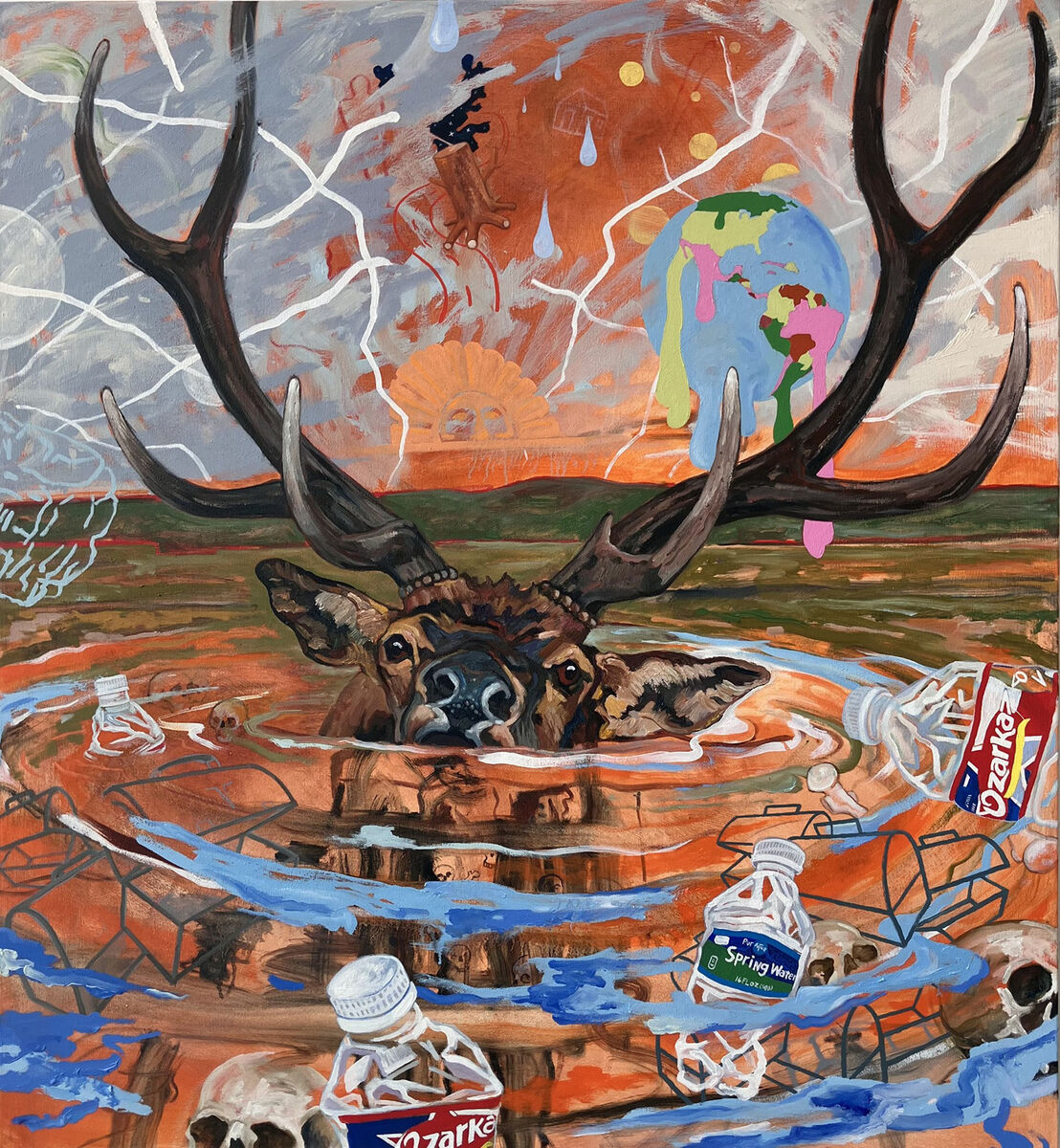On view in the Edgar Heap of Birds Family Gallery
Sept. 5–Dec. 19, 2025
Artist Talk: Sept. 12, 2025, 3–4:30 p.m. with reception to follow, 5–7:30 p.m.
Temple Contemporary announces “Navigating New Places: Norman Akers,” the culminating exhibition of works created by Osage artist Norman Akers as the inaugural Edgar Heap of Birds Family Artist in Residence at Temple University’s Tyler School of Art and Architecture. The five-month residency was established through a gift from Tyler alum Edgar Heap of Birds (MFA ’79), a leading Native American artist, educator and activist, and provides time and resources for artists to expand their studio practice while working with Tyler students. Opening Sept. 5, the exhibition features lithographs and six new large-scale paintings produced during Akers’ stay in Philadelphia, exploring Indigenous perspectives on sense of place, political boundaries, and cultural survival.
“The Edgar Heap of Birds Family Residency provided a gift of time and the opportunity to immerse myself in making paintings, to get lost in the creative process, and find those moments where the work makes connections to this moment in time,” Akers said.
Working in Philadelphia, which Akers calls “the birthplace of American colonialism,” the artist produced works that express deeply felt concerns regarding removal, disturbance, and the struggle to reclaim cultural context. His residency paintings include a reinterpretation of symbols such as the Liberty Bell, challenging patriotic narratives through an Indigenous lens.
Mapping and Cultural Continuity
The exhibition includes large-scale paintings that employ layered imagery to suggest a non-linear sense of time and a grid of lithographs referencing colonial mapping systems. Texts highlight Akers’ Osage philosophical perspectives on movement and cultural continuity.
“Akers’ work deepens our understanding of place and Indigenous worldbuilding,” said Matthew Jordan-Miller Kenyatta, director of exhibitions and public programs at Temple Contemporary. “This show advances Temple Contemporary’s commitment to designing for a pluriverse — spaces where multiple ways of knowing, moving and being can coexist and inform one another.”
In the center of the gallery, a wooden bench modeled and fabricated following instructions from Akers, invites visitors to pause within what Akers describes as a “mythic landscape [that allows for] the formation of intangible constructs of Osage lifeways, beliefs and a worldview that reflects our culture, our connection to the spiritual, our connection to the land and an awareness of the natural world.”
Residency Impact
“Norman’s presence in our studios created invaluable opportunities for students and faculty to engage directly with him and learn how he sees the world,” said Susan E. Cahan, dean of the Tyler School of Art and Architecture. “We are sincerely grateful to Edgar and his family. In establishing the Edgar Heap of Birds Family Artist Residency, he demonstrates an Indigenous way of contributing back to the community.”
Akers has a well-established visual vocabulary of images and symbols derived from his cultural heritage. The residency gave him five uninterrupted months to spend long days in the studio, an experience that helped him push beyond familiar territory.
“I find that the best moments in making art are when that uncomfortable feeling of not knowing is felt. Then I know it’s ‘good’ because the work is embracing new information and is now teaching me. The act of painting is very much about navigating new places,” said Akers.
View Sept. 12 Artist Talk Event Details

Norman Akers, Staying Afloat, 2025, oil on canvas, 50 x 46 inches, courtesy of Norman Akers.
ABOUT NORMAN AKERS
Norman Akers (b. 1958; Wahzhazhi/Osage) was born in Fairfax, Oklahoma, where the landscapes of Osage country influenced both his identity and his art. After earning a BFA in painting from the Kansas City Art Institute in 1982, he completed a certificate in Museum Studies at the Institute of American Indian Arts and later an MFA in painting from the University of Illinois at Urbana–Champaign.
In addition to his studio practice, Akers is an associate professor of visual art at the University of Kansas and serves as chairman of the Osage Nation’s Traditional Cultural Advisory Board, continuing his lifelong commitment to storytelling and cultural preservation. His art has been exhibited widely, including at the Smithsonian’s National Museum of the American Indian, Crystal Bridges Museum of American Art and the Nelson-Atkins Museum. His work is held in the collections of the Library of Congress, the Denver Art Museum and the Minneapolis Institute of Art, among others. He received the Joan Mitchell Painters & Sculptors Grant in 1999.
ABOUT THE EDGAR HEAP OF BIRDS FAMILY ARTIST IN RESIDENCE
The Edgar Heap of Birds Family Artist Residency and Exhibition Program is designed to support artists whose work is primarily focused on the history and lived experience of North American federally recognized tribal citizens and whose art and activism brings attention to the lives, struggles, and triumphs of Native Americans. The residency program brings artists to Tyler who might not otherwise have access to the school’s studio facilities, faculty, and staff. Focusing on a group of artists that is radically underrepresented in the arts, the residency provides a sustainable program of educational opportunities for students and the public. Hock E Aye Edgar Heap of Birds, (b. 1954; Cheyenne and Arapaho Nation, MFA ‘79) is an alum of the Tyler School of Art and Architecture.
ABOUT TEMPLE CONTEMPORARY
Temple Contemporary serves as a beacon for art, architecture and community imagination along the North Broad cultural corridor. The 3,400-square-foot gallery, located within Tyler School of Art and Architecture at Temple University, champions experimental practices that center joy, justice and genius while fostering dialogue between academic and community knowledge. Temple Contemporary has an artistic lineage stretching back to the mid-1980s, formerly located in the University’s Center City building, then to Philadelphia’s Old City gallery district before relocating to Temple University’s Main Campus in North Philadelphia in 2009. More information is available on Instagram at @temple_contemp and online.

